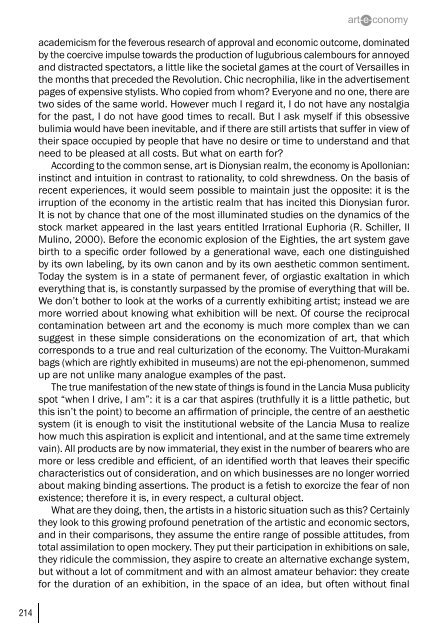art-e-conomy _ reader - marko stamenkovic
art-e-conomy _ reader - marko stamenkovic
art-e-conomy _ reader - marko stamenkovic
You also want an ePaper? Increase the reach of your titles
YUMPU automatically turns print PDFs into web optimized ePapers that Google loves.
214<br />
academicism for the feverous research of approval and economic outcome, dominated<br />
by the coercive impulse towards the production of lugubrious calembours for annoyed<br />
and distracted spectators, a little like the societal games at the court of Versailles in<br />
the months that preceded the Revolution. Chic necrophilia, like in the advertisement<br />
pages of expensive stylists. Who copied from whom? Everyone and no one, there are<br />
two sides of the same world. However much I regard it, I do not have any nostalgia<br />
for the past, I do not have good times to recall. But I ask myself if this obsessive<br />
bulimia would have been inevitable, and if there are still <strong>art</strong>ists that suffer in view of<br />
their space occupied by people that have no desire or time to understand and that<br />
need to be pleased at all costs. But what on e<strong>art</strong>h for?<br />
According to the common sense, <strong>art</strong> is Dionysian realm, the e<strong>conomy</strong> is Apollonian:<br />
instinct and intuition in contrast to rationality, to cold shrewdness. On the basis of<br />
recent experiences, it would seem possible to maintain just the opposite: it is the<br />
irruption of the e<strong>conomy</strong> in the <strong>art</strong>istic realm that has incited this Dionysian furor.<br />
It is not by chance that one of the most illuminated studies on the dynamics of the<br />
stock market appeared in the last years entitled Irrational Euphoria (R. Schiller, Il<br />
Mulino, 2000). Before the economic explosion of the Eighties, the <strong>art</strong> system gave<br />
birth to a specific order followed by a generational wave, each one distinguished<br />
by its own labeling, by its own canon and by its own aesthetic common sentiment.<br />
Today the system is in a state of permanent fever, of orgiastic exaltation in which<br />
everything that is, is constantly surpassed by the promise of everything that will be.<br />
We don’t bother to look at the works of a currently exhibiting <strong>art</strong>ist; instead we are<br />
more worried about knowing what exhibition will be next. Of course the reciprocal<br />
contamination between <strong>art</strong> and the e<strong>conomy</strong> is much more complex than we can<br />
suggest in these simple considerations on the economization of <strong>art</strong>, that which<br />
corresponds to a true and real culturization of the e<strong>conomy</strong>. The Vuitton-Murakami<br />
bags (which are rightly exhibited in museums) are not the epi-phenomenon, summed<br />
up are not unlike many analogue examples of the past.<br />
The true manifestation of the new state of things is found in the Lancia Musa publicity<br />
spot “when I drive, I am”: it is a car that aspires (truthfully it is a little pathetic, but<br />
this isn’t the point) to become an affirmation of principle, the centre of an aesthetic<br />
system (it is enough to visit the institutional website of the Lancia Musa to realize<br />
how much this aspiration is explicit and intentional, and at the same time extremely<br />
vain). All products are by now immaterial, they exist in the number of bearers who are<br />
more or less credible and efficient, of an identified worth that leaves their specific<br />
characteristics out of consideration, and on which businesses are no longer worried<br />
about making binding assertions. The product is a fetish to exorcize the fear of non<br />
existence; therefore it is, in every respect, a cultural object.<br />
What are they doing, then, the <strong>art</strong>ists in a historic situation such as this? Certainly<br />
they look to this growing profound penetration of the <strong>art</strong>istic and economic sectors,<br />
and in their comparisons, they assume the entire range of possible attitudes, from<br />
total assimilation to open mockery. They put their p<strong>art</strong>icipation in exhibitions on sale,<br />
they ridicule the commission, they aspire to create an alternative exchange system,<br />
but without a lot of commitment and with an almost amateur behavior: they create<br />
for the duration of an exhibition, in the space of an idea, but often without final


